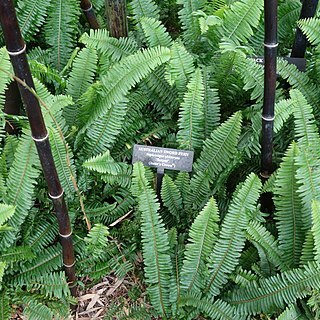Rhizome 1-2 mm diam., stramineous to reddish brown, patched with matted hairs; scales appressed, deciduous, narrowly ovate, 0.75-2 by 0.5-1 mm, reddish black, in centre with strongly thickened cell-walls, sometimes covered by red-brown hairs, margins with sessile or slightly elongate glandular hairs. Phyllopodia 9-50 mm apart, to 5 mm long, 1-2 mm diam., stramineous to reddish brown; glabrous. Stipes to 8 mm long, 1-3 mm diam.; increasingly more abundantly hairy towards the rhachis, hairs simple, short, straight to curved, septation obscure. Rhachis sparsely to densely hairy on lateral and abaxial surfaces, glabrous on adaxial surface. Lamina pinnate, 25-50 by 2.5-6.5 cm, gradually tapering towards base, often gradually tapering towards apex. Pinnae 25-45 pairs, 5-14 mm apart, trapezoidal-oblong to triangular, slightly falcate, 9-55 by 3-12 mm; base strongly unequal, acroscopic margin parallel to nearly parallel to the rhachis, auricled, basiscopic margin strongly narrowed, perpendicular to nearly perpendicular to the rhachis; midrib curved towards the point of attachment in the basiscopic corner, margins crenate-serrate, sometimes entire; apex rounded; lower pinnae reflexed, almost reduced to auricles, upper pinnae reduced and merging with the apical pinna or not reduced and distinct from the apical pinna. Apical pinna articulated to rhachis, more or less distinct from adjacent lateral pinnae, or sometimes merging with rhachis and adjacent lateral pinnae, 8-37(-72) by 6-12(-20) mm, narrowly ovate, apex acute; apical pinnae aborted in epilithic fronds. Secondary veins forked once, or several times on basal auricle. Indument on both surfaces absent or consisting of simple, straight or curved hairs, sparser towards distal end of costa. Hydathodes clearly visible, rarely covered with lime-scales. Sori supramedial, ± 1.5 mm diam., indusia surface glabrous, rarely hairy, margin entire, rarely toothed.
More
Rhizome c. 1 mm diam.; upper surface densely covered when young with minute appressed black-brown scales (frequently lost with age) which sometimes bear scattered simple fragile marginal hairs. Fronds 5-31 cm long, tapering towards base and partly to apex; uppermost pinna pair and terminal pinna usually distinctly enlarged. Stipes ±absent; rachis bearing short curled hairs; indumentum dense on the lower surface, rare to absent on the upper surface and (rarely) scattered scales. Pinnae 8-55 mm long, 4-12 mm wide, bearing similar hairs on proximal part of upper and lower midrib; margins entire or crenulate; apex rounded or sometimes acute in upper pinnae, usually with a low rounded basal auricle. Sori superficial, at two-thirds distance from midrib to margin and usually present within auricle; indusium round, glabrous.
Rhizome long creeping, up to 2-3 m, ca. 2 mm in diam., covered with ovate, dark brown, fimbriate scales. Fronds 5-10 cm apart; stipe 1-2 cm; lamina lanceolate, 15-40 × 4-8.5 cm; pinnae 30-40 pairs, alternate, 2-4 × ca. 1 cm, articulate to rachis, sessile, base asymmetrical, usually auriculate on upper side, margin undulate or crenate, apex rounded; lower pinnae shortened, deflexed; rachis densely covered with brown glandular hairs and scales abaxially, shallowly grooved adaxially. Sori nearer margin than costa; indusia brown, orbicular-reniform, glabrous.

